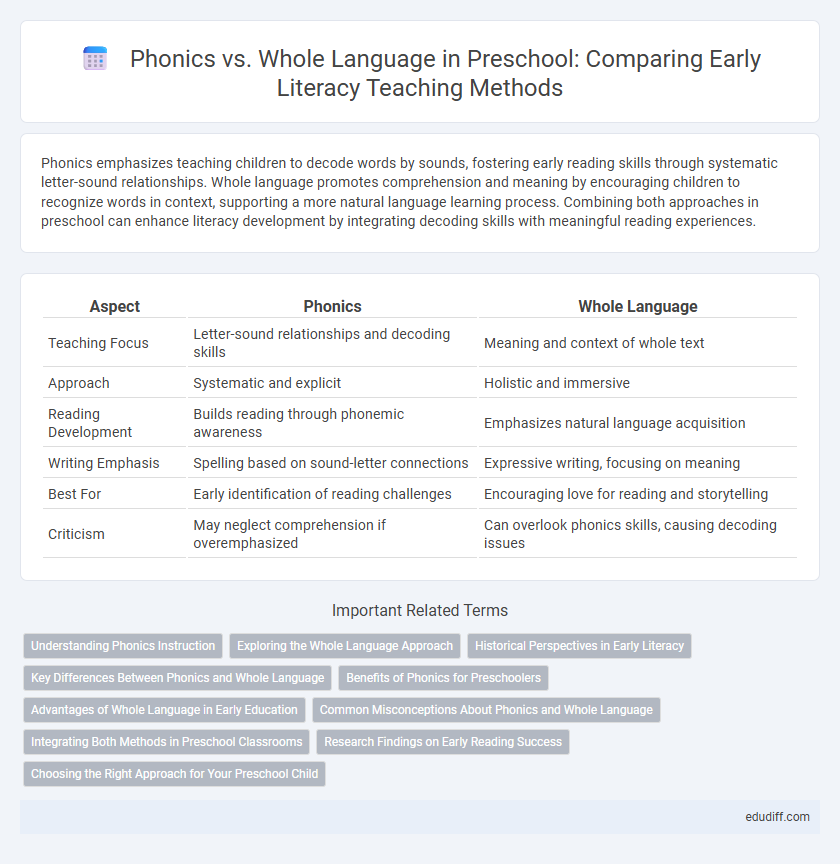Phonics emphasizes teaching children to decode words by sounds, fostering early reading skills through systematic letter-sound relationships. Whole language promotes comprehension and meaning by encouraging children to recognize words in context, supporting a more natural language learning process. Combining both approaches in preschool can enhance literacy development by integrating decoding skills with meaningful reading experiences.
Table of Comparison
| Aspect | Phonics | Whole Language |
|---|---|---|
| Teaching Focus | Letter-sound relationships and decoding skills | Meaning and context of whole text |
| Approach | Systematic and explicit | Holistic and immersive |
| Reading Development | Builds reading through phonemic awareness | Emphasizes natural language acquisition |
| Writing Emphasis | Spelling based on sound-letter connections | Expressive writing, focusing on meaning |
| Best For | Early identification of reading challenges | Encouraging love for reading and storytelling |
| Criticism | May neglect comprehension if overemphasized | Can overlook phonics skills, causing decoding issues |
Understanding Phonics Instruction
Phonics instruction in preschool involves teaching children the relationship between letters and sounds, which helps develop decoding skills essential for reading. Research indicates that systematic phonics approaches enhance early literacy by enabling children to recognize words quickly and improve reading fluency. Emphasizing phonemic awareness alongside letter-sound correspondence supports children's ability to decode unfamiliar words independently.
Exploring the Whole Language Approach
The whole language approach in preschool emphasizes holistic reading experiences by integrating listening, speaking, reading, and writing within meaningful contexts. This method encourages children to recognize words through exposure to rich literature and authentic communication rather than isolated phonetic drills. Research indicates that whole language promotes language comprehension and fosters a love for reading by connecting text to real-world experiences.
Historical Perspectives in Early Literacy
Historical perspectives in early literacy reveal that phonics and whole language approaches have long been debated as foundational methods in preschool education. Phonics emphasizes systematic instruction in letter-sound relationships, which gained prominence in the mid-20th century as evidence mounted supporting its effectiveness in decoding skills. In contrast, the whole language approach, emerging in the 1980s, promotes immersion in rich, meaningful text, focusing on comprehension and context rather than isolated phonetic rules.
Key Differences Between Phonics and Whole Language
Phonics emphasizes systematic instruction in letter-sound relationships, enabling preschoolers to decode words by blending sounds, while Whole Language focuses on meaning and context, encouraging children to recognize words through exposure to authentic texts. Phonics prioritizes explicit teaching of phonemic awareness and decoding skills, whereas Whole Language relies on immersive reading experiences and holistic comprehension. Research supports phonics for foundational reading skills, but integrating both approaches can cater to diverse learning styles in early childhood education.
Benefits of Phonics for Preschoolers
Phonics instruction in preschool enhances early reading skills by teaching children the relationship between letters and sounds, which supports decoding unfamiliar words independently. This systematic approach improves phonemic awareness, enabling preschoolers to develop strong foundational literacy skills essential for reading fluency and comprehension. Research shows that phonics-based learning significantly boosts vocabulary growth and spelling accuracy in young learners compared to whole language methods.
Advantages of Whole Language in Early Education
Whole language in early education fosters natural reading development by emphasizing meaning and context, which enhances children's comprehension skills. This approach encourages a love for reading through exposure to rich, authentic texts, promoting vocabulary growth and critical thinking. Integrating speaking, listening, reading, and writing activities supports holistic language acquisition and social interaction in preschoolers.
Common Misconceptions About Phonics and Whole Language
Many educators mistakenly believe phonics instruction limits creativity, while whole language fosters better comprehension; however, phonics develops essential decoding skills crucial for early reading success. Another misconception is that whole language alone suffices for literacy, ignoring the structured skill-building phonics provides to decode words accurately. Effective preschool reading programs integrate phonics and whole language strategies to support both word recognition and meaningful language use.
Integrating Both Methods in Preschool Classrooms
Integrating phonics and whole language approaches in preschool classrooms enhances early literacy by combining systematic letter-sound instruction with meaningful, context-rich reading experiences. This hybrid method supports diverse learning styles, promoting phonemic awareness alongside vocabulary development and comprehension skills. Educators can tailor instruction to individual needs, fostering a balanced foundation for reading readiness and long-term academic success.
Research Findings on Early Reading Success
Research findings indicate phonics instruction significantly improves early reading success by enhancing children's ability to decode words through systematic letter-sound relationships. In contrast, whole language approaches emphasize meaning and context but often lack explicit decoding strategies, which may hinder struggling readers' progress. Studies consistently show that integrating phonics with meaningful text exposure yields the most effective early literacy outcomes.
Choosing the Right Approach for Your Preschool Child
Selecting the right approach for your preschool child involves understanding the key differences between phonics and whole language methods. Phonics emphasizes systematic instruction in letter-sound relationships, supporting early decoding skills, while whole language focuses on immersion in rich, meaningful texts to promote natural language acquisition. Tailoring these strategies to your child's learning style and developmental readiness enhances literacy outcomes and fosters a lifelong love of reading.
Phonics vs Whole language Infographic

 edudiff.com
edudiff.com